Brave New World: Possibilities for Diversity in VR Technology
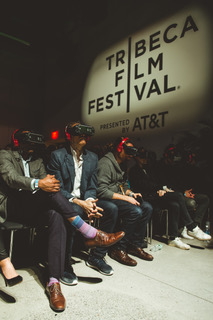
Rebecca M. Alvin Reports on Virtual Reality and Immersive Storytelling at this Year’s Tribeca Film Festival
The seeds of virtual reality were planted decades ago. In fact, some would say, conceptually, it dates back to the origins of cinema. But it’s only since the advent of smartphones that the industry has really become available to everyone. Essentially, virtual reality is a term that refers to a type of media in which the user is immersed in a computer-generated world within which (s)he can interact and move around, at least to some degree. More recently, at important VR showcases such as the annual Tribeca Film Festival in New York, these experiences have been categorized under the banner of “immersive storytelling,” emphasizing one of the key aspects of VR’s appeal: the users’ temporary impression that they are actually alive within the virtual world.
If your only experience with immersive storytelling was the programming at the Tribeca Film Festival, you might think the field is about as open and diverse as one could possibly imagine. While hardly the actual state of things, Tribeca offers an alternative to the conventional landscape of immersive storytelling, one that hopefully points toward future realities.
Senior Programmer for Feature Films and Immersive Programming at Tribeca, Loren Hammonds, thinks this focus on openness and diversity is pretty important. “When you have stories coming from similar perspectives, ultimately your program is boring,” says Hammonds. “So it’s more exciting to me to get some diversity in subject matter and also in the creators themselves. The creators themselves are informing what we’re seeing. So, that’s another thing that really excites me about VR; you have a lot of women and people of color coming into it and telling their stories in new and innovative ways. It’s not really questioned exactly. It’s just appreciated as new work.”
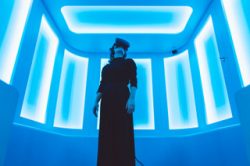
Image Courtesy of Tribeca Film Festival
When film began at the turn of the last century, racism, sexism, and homophobia were undeniable and mostly unquestioned aspects of society. And yet, as this new industry came about, women and minorities did make films, working in front of and behind the camera and even owning and running their own companies. Perhaps it was because the original moviemakers were often immigrants, who had different historical perspectives compared with other Americans. Perhaps it was because it wasn’t initially a huge industry with the economic and cultural power that Hollywood has today. Or maybe it was the fact that it was seen as a low form of entertainment in those days before film studies programs. In any case, that diversity disappeared rather quickly, and while women and people of color continued to make films, they were certainly marginalized, and their works were not preserved for us to look at now with 21st-century eyes.
Fast-forward to 2018. Virtual reality is just beginning to come into its own. With connections to gaming, film, marketing, and computer science, it’s anyone’s guess where VR will end up. But right now, we are in a similar place as those early days of cinema. The doors are still open. Work is being made by and about women, people of color, LGBTQ+ people, and the many intersectional identities that we now recognize. Is this a window of opportunity that could be shut at any moment, or are we past that?
Tribeca’s programming team has managed to develop its festival into an annual showcase for works made by people coming from a lot of different creative spaces, different cultural backgrounds, and very distinct points of view. But it’s not just a case of checking off boxes on some diversity checklist. Programmers are careful in selecting a well-rounded repertoire, including a broad range of approaches to immersive media. Just as the festival’s film programming has documentaries, shorts, animated works, as well as live-action narrative features, the immersive programming has VR and Augmented Reality (AR) pieces that are room-scale installations and some that confine you to a smaller space within which to experience the work. Each piece incorporates different levels of interactivity with cutting edge technologies whose capabilities are only just being discovered. At this year’s Festival, which ran April 18 – 29, a new section was added under the Immersive Storytelling umbrella. The new Cinema360 sidebar offered immersive films, shot with 360 video and screened for an audience in a theater, which is distinct from the other immersive experiences that are individual. Although audience members wore headphones and VR headsets and swiveled around in their chairs, the idea was to try to create a theatrical space similar to what we have with film, while still offering an experience that was to some degree personalized. The exhibit was truly international and interdisciplinary. Artists from around the world represented a wide variety of fields: filmmaking and the arts, psychology, gaming, and computer science. While on the gaming industry side there are still significant obstacles to overcome in terms of a long-standing tradition of male dominance and a well-documented lack of diversity, there is another part of the virtual reality landscape that does in fact feel innately open and embracing of women, LGBTQ+ people, and people of color as creators and subjects. Just as there has always been a response to mainstream Hollywood film production with independents, avant-garde, and underground cinema, VR and other forms of immersive storytelling are used in many ways, from the mainstream to the countercultural. We’re at the very beginning of something that has the potential to be fundamentally different in how open to diverse voices it can, and hopefully will, remain.
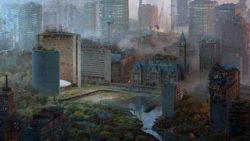
Three projects at this year’s edition of the Tribeca Film Festival demonstrate what Hammonds is talking about when he says the VR storytelling space is one in which creators from a multitude of backgrounds can get their stories out there. Queerskins is an interactive VR piece housed in an installation. An outgrowth of a highly detailed online work of the same name, Queerskins places you literally in the back seat of a car with a box of mementos of the deceased character Sebastian, who died of AIDS. His parents sit in the front seat arguing about their child’s homosexuality and the deep loss, regret, and shame they feel. It takes place in Missouri in the early 1990s. The technology includes both the usual headset/headphones used in VR and a hand controller, with which you can interact with the boxes of his belongings. Before and after being fitted with the gear, there is a real life environment to walk through and interact with. The makers even encourage you to move things around and take mementoes from the installation, creating an experience that is both technologically absorbing and physically engaging, demonstrating a recognition of that which technology cannot yet give us: direct, tactile interaction with real-life objects.
Speaking by phone a few weeks after the festival, Illya Szilak, who created the piece with Cyril Tsiboulski, explains, “We are always interested in incorporating what is actually existent in people’s lives, and actually crowdsourcing a lot of stuff, because for us that recognition of embodied material, historical reality is what we sort of play off against— I know this speaks for myself—what I see as probably the most quintessential human characteristic, which is a reach to transcend those limitations of material, historical reality, and that’s through art, through religion, through sex, through storytelling, in and of itself, but always going back to the fact that in VR you can pretend to be X, Y, and Z for five minutes, but when you take off the headset, you’re still going to have to deal with the sociopolitical, economic realities of being Black in America or being queer in America, or being a woman in America. You’re still going to have that, so it’s really important for us, ethically, to recognize that.”
A very different, but no less powerful, project at Tribeca this year was 1,000 Cut Journey, created by a team of researchers at both Columbia University and Stanford University, led by psychologist Dr. Courtney Cogburn, whose work centers on the impact of racial bias on inequality in health care. This piece is not as layered as Queerskins, but it also takes on virtual reality as what’s being called “an empathy machine.” The medium’s ability to let you walk in someone else’s shoes in a far more direct way than you can in a book or movie, for example, is leading to academic studies on the issue, particularly in regard to important social dynamics such as race, gender, and sexuality. In this project, meant for people who are not African-American, the user finds themselves in the body of a Black male, first as a kindergartener, then as a teenager, and finally as an adult. While wearing the headset, you look in a mirror and see that you are Black through your computer-generated reflection. Then you go through several interactions with the rest of the world and experience things that African-American men have experienced, including an extremely potent interaction with police that forces you to your knees.
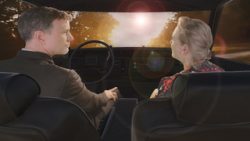
Cogburn, who is Black, says responses to the program affirmed what she’d hoped to accomplish in eliciting empathy from the primarily white users at Tribeca. In addition, she found the immersive experience had a powerful impact on African-American observers who watched white participants go through the experience in Tribeca’s very public Virtual Arcade space. “I think some of the responses from Black people, in particular, were that it feels very authentic and familiar in ways that are really uncomfortable. But they also talked about—which I didn’t expect—the experience of watching white people go through the experience and how that was emotional for them to see,” Cogburn says. “It wasn’t designed for people of color; it was designed for whites, so it’s been interesting to get a sense of their reaction to seeing their experience for the purpose of educating white people, basically. So we had lots of interesting discussions.”
While Queerskins and 1,000 Cut Journey exemplify immersive projects that focus on a specific story, Lisa Jackson’s Biidaaban is an extraordinary work that challenges you to come up with the story as you experience a future state in which nature has overcome the city of Toronto. This non-narrative project incorporates different Native American and Canadian First Nations languages, including Ojibwe, Wendat, and Mohawk. Upon entering the Biidaaban space, you read on the wall a truncated version of a Mohawk creation story. Then you are helped into your VR gear which brings you into this world that at first glance appears post-apocalyptic, but as its context is revealed to you through the language spoken and also appearing as text, you begin to feel more hopeful about a future in which nature still reigns supreme, even as a once-thriving manmade environment lies in ruins. The gear allows you to leap off of a roof, wander around a deserted train station, and if you are observant, see signs of life in both human and animal form. At the very end of the experience, after your gear is removed, you are led out to a post-experience room with a live turtle in a tank, a motif that appears within the VR environment as well, and which grounds us in nature even in the context of a high-tech environment.
Jackson, who is Anishinaabe, is hopeful about inclusivity in this emerging medium. Her ethnicity informed her production in ways both visible and not visible to the audience. For example, using indigenous languages and deciding how long to have the text up before the English translation appears were decisions that required an intricate understanding of cultural differences. “That required a whole lot of consultation with the community because there are different perspectives, but amongst a lot of real traditionalists, there’d be a big question about even writing it down because the nature of their language and their culture and their spiritual traditions is oral based, so there’s a lot of conversation about the value of writing these things down at all,” says Jackson. “So we did a fairly significant consultation process with a number of different people involved to sort of see early on whether or not it would be possible.”
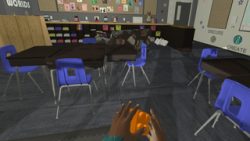
Each of these experiences was a unique one for many reasons, including cultural, technical, creative, and personal differences. Having all of them, and many more, a part of a larger immersive storytelling conversation at Tribeca shows us what is possible. But this openness is a fragile condition. The diversity of voices involved at the beginning of cinema was soon narrowed, and much of the work by people of color and women is gone forever. Once film, as a medium, became an industry, the white male-dominated power structure was put into place and those voices were silenced. While a diverse range of artists continued to work, as evidenced by what has survived (for example in films of Lois Weber, Oscar Micheaux, and Alice Guy-Blaché), the full scope of this output and its various perspectives and visions has been lost.
As Hammond explains, “Traditional film, as an industry that has been around for such a long time, has had a chance to kind of alienate certain groups of people, whereas VR, being a new medium doesn’t really have to play catch up at any point. I think that if there are diverse voices with something to say, to the credit of the studios and the funders and the technologists that are working in it, they are fully embracing creators with diverse voices to tell their stories, and I think everyone can agree that just makes the storytelling richer.”
